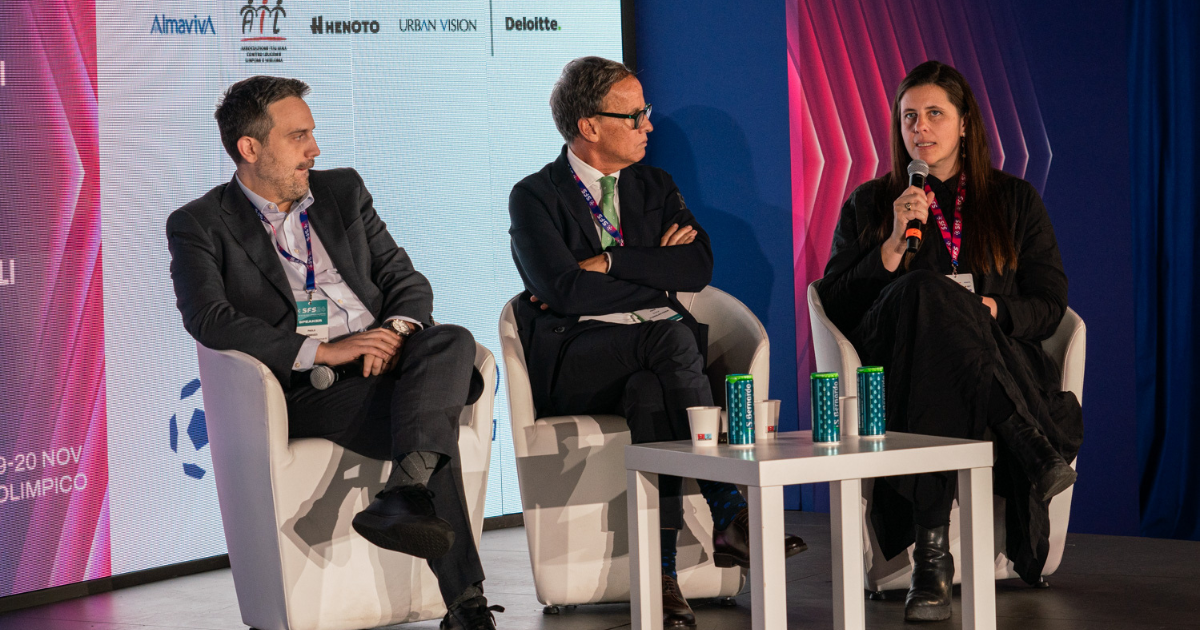
Venue visions: the future of sport facilities
From the new Spotify Stadium to the Allianz in Turin, passing through the new projects planned, such as integrating technology and events.
The vision of the venue where sporting events take place, and not only, was at the heart of the panel moderated by Ivan Ortenzi, which saw the participation of Jordi Penas, head of the Barcelona Museum, Paolo Monguzzi, Stadium & Consumer Business Director of Juventus Football Club, Luca Montebugnoli, Founder Chairman and CEO of Vivaticket, and Silvia Prandelli Senior Principal of Populous.
A panel where suggestions related to the future of physical spaces and the technological integrations that can bring in new fan bases and new customers were discussed.
Jordi Penas focused on the fact that the Spotify Stadium will soon be completed: “The work will be fully completed by 2026 at the latest.” A suggestive video was shown in the room, showcasing the construction progress as seen from the window of the Barcelona executive’s office. “7,000 people work on it every day”.
Penas also emphasized that “Sustainability is at the heart of the project and that 75% of the energy will come from solar panels, and the Barca Museum will be in the stadium as early as next summer.” In the meantime, a temporary museum is active where history and the latest technologies intertwine.
Regarding the theme, the Barcelona executive explained that the Camp Nou is used 30 days a year: “We need to use it the other 330 days and to do so we must innovate and use technology”.
Paolo Monguzzi of Juventus was on the same wavelength: “Once a new place is built, the surprise effect must be constant. It must fascinate the 4-year-old child, the one who always follows Juventus, and the one who returns to the stadium after years“.
“The stadium,” the Juventus executive emphasized, “is like a small city, it must welcome everyone, and this applies to all Venues”.
Highlighting the need to always be open to new challenges, “I cannot rely on the fact that today it is the most modern, tomorrow it will no longer be”.
“The key word is ambition,” Monguzzi concluded, “There will be new stadiums, but we want to remain the most beautiful and the most modern”.
And speaking of modern stadiums with a great impact, the video presented by Silvia Prandelli of Populous showed how “Technology is used to create the surprise effect and the sense of belonging to the Venue. The journey is therefore always new”.
Explaining the importance of “Knowing your audience and understanding the intergenerational spectator. Building buildings as containers of experiences and how to make these experiences social and iconic at the same time”.
To do this, it is crucial to work with “Sustainability and social sustainability, influencing the design process with them. A Venue for everyone, both in match mode and non-match mode.” A direct example is that of opening areas on non-match days, making them removable and reconfigurable.
Luca Montebugnoli of VivaTicket, in a remote connection, underlined the concept of “No paper ticketing” and above all of integration between the ticketing app and local services, starting with transport and social cards.
At the same time, he highlighted a series of consolidated keys: “Moving the experience to the Digital, therefore buying everything with a smartphone. Enriching the database to accompany customers with ad hoc services from Home to the Venue and seeing them throughout the week. Creating an ecosystem”.
How to do it? “Innovation and flexibility, the New York Arena has 100% of subscribers, 80% of whom are flexible.” A leap into the future.



